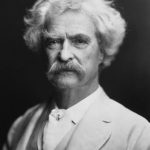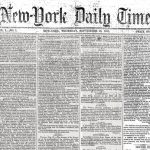 Mark Twain said, “There are three kinds of lies: plain lies, damn lies, and statistics.”
Mark Twain said, “There are three kinds of lies: plain lies, damn lies, and statistics.”
He might have said four, adding headlines to the list. I suppose that was true when Twain was a journalist, but misleading headlines seem to have reached an art form in the age of social media.
At least when a headline had to be put into print with 56 point type (that is: great big letters!) in limited space, headline writers had to be very good.
Being a headline writer was, and perhaps still is, an actual role. That makes perfectly good sense to me, because every form of writing has its own nuances and skill set. When I was doing a lot of lyric writing, everything sounded like it could be a song.
Expressing a thought in a song is a very different task than expressing that same thought in a short story. The short story is very different than writing a novel, and a novel is not the same as a stage play.
There are those who can write well in all of those disciplines, but they are rare. As for writing headlines, how hard can it be?
Apparently pretty hard.
Surely not
You might think that a headline is simply a short way of telling you what is in the story you are about to read, and you would be correct. But it is more than that, especially in our social media world.
First, can you imagine a newspaper without headlines? (If you are under 20, can you imagine a newspaper?)
 Without headlines, we are presented with a page filled with print appearing in columns and blocks. Here is a picture of the first edition of the New-York Daily Times, which later became the New York Times. The date is September 18, 1851 and the cost is 1¢.
Without headlines, we are presented with a page filled with print appearing in columns and blocks. Here is a picture of the first edition of the New-York Daily Times, which later became the New York Times. The date is September 18, 1851 and the cost is 1¢.
I suppose it wasn’t long before those tiny headlines grew larger–which is a whole other aspect of headlines signifying the importance (or lack thereof) of an article.
So the primary purpose of headlines, at least early on, was to differentiate one article from another, and the intent was to tell the reader what the article was about.
But what is information if it can’t be used to persuade in some way or another? And so in time headlines became, even in newspapers and on magazine covers, little hooks to catch readers and reel them in.
Information might still be there, but enticement was taking a larger role.
The New-York Daily Times of September 18, 1851 didn’t have a lot of competition. Today is different.
In fact statistics from late 2022 say there are 600 million blogs on the internet and 1.9 billion web sites. Newspapers? They are still around, which is pretty cool. The top two (USA Today and Wall Street Journal) each have a circulation greater than 1,000,000.
How does anyone get readers for all of that information? Content is king, but headlines help.
Misleading, or just wrong?
“Misleading” means giving the wrong idea or impression. Headlines can do that in ten words or less.
Consider this:
Disney workers rebel against return to office mandate
That is an actual headline from just a few days ago. Is it misleading? If you read the article you learn that around 2,300 employees have signed a petition asking the CEO to change his announced “back to the office” plan.
 That represents about 1% of the 220,000+ employees at Disney. Suppose you have a workforce of thousands — or even hundreds — that had worked remotely for a lengthy period of time. Now suppose you decide to have them come back to work in the office. Would you be surprised if 1% protested that decision in some way? 5%?
That represents about 1% of the 220,000+ employees at Disney. Suppose you have a workforce of thousands — or even hundreds — that had worked remotely for a lengthy period of time. Now suppose you decide to have them come back to work in the office. Would you be surprised if 1% protested that decision in some way? 5%?
And did they rebel? No, they signed a petition and made their voice heard. Hardly a rebellion.
There are, of course, headlines that are not so much misleading as just plain bad. Here are some that were ferreted out three years ago by folks at The Bored Panda.
‘We hate math,’ say 4 in 10 — a majority of Americans
Marijuana issue sent to a joint committee
Missippi’s literacy program shows improvement
Influence
Because you are a smart person, you are unlikely to be misled very far by a headline. Even so, it is likely that your opinion of an article could be influenced by a headline.
First impressions really do matter, and a headline is a first impression.
Golf Magazine online the other day had “Tiger Woods’ tone-deaf prank puts damper on otherwise thrilling day.”
Any headline leading with Tiger is guaranteed to get readers. Cast Tiger in a negative light, as this did, and many who read the article will come to it with that impression.
Written by the magazine’s executive editor, it was basically an opinion piece — though it was listed as news.
Studies show that even a slightly misleading headline has a big impact on how readers recall an article, whether it is news or opinion. In fact research shows that for many readers, the article doesn’t even get read. Apparently more and more people are simply scanning headlines and going no deeper.
Truth
What does all of this have to do with doing good? Simply that many of us are unwitting victims to a very subtle form of falsity — headlines written to support a bias.
A 2014 article in the New Yorker on this topic included the following:
“Air pollution now leading cause of lung cancer,” ran a headline last year in the U.K. paper Daily Express. The article, however, said no such thing, or, rather, not exactly. Instead, it reported that pollution was a leading “environmental” cause; other causes, like smoking, are still the main culprits.
We want facts when we read the news, and we’re fine with opinions when they are presented as such. In either case we want headlines that tell the truth about what is in the article.
Especially when you are online, read headlines with discernment. Be wary of those that lead you more than they inform you. After all, words mean things.
Do good. It’s in you!
Headlines: let the reader beware
He might have said four, adding headlines to the list. I suppose that was true when Twain was a journalist, but misleading headlines seem to have reached an art form in the age of social media.
At least when a headline had to be put into print with 56 point type (that is: great big letters!) in limited space, headline writers had to be very good.
Being a headline writer was, and perhaps still is, an actual role. That makes perfectly good sense to me, because every form of writing has its own nuances and skill set. When I was doing a lot of lyric writing, everything sounded like it could be a song.
Expressing a thought in a song is a very different task than expressing that same thought in a short story. The short story is very different than writing a novel, and a novel is not the same as a stage play.
There are those who can write well in all of those disciplines, but they are rare. As for writing headlines, how hard can it be?
Apparently pretty hard.
Surely not
You might think that a headline is simply a short way of telling you what is in the story you are about to read, and you would be correct. But it is more than that, especially in our social media world.
First, can you imagine a newspaper without headlines? (If you are under 20, can you imagine a newspaper?)
I suppose it wasn’t long before those tiny headlines grew larger–which is a whole other aspect of headlines signifying the importance (or lack thereof) of an article.
So the primary purpose of headlines, at least early on, was to differentiate one article from another, and the intent was to tell the reader what the article was about.
But what is information if it can’t be used to persuade in some way or another? And so in time headlines became, even in newspapers and on magazine covers, little hooks to catch readers and reel them in.
Information might still be there, but enticement was taking a larger role.
The New-York Daily Times of September 18, 1851 didn’t have a lot of competition. Today is different.
In fact statistics from late 2022 say there are 600 million blogs on the internet and 1.9 billion web sites. Newspapers? They are still around, which is pretty cool. The top two (USA Today and Wall Street Journal) each have a circulation greater than 1,000,000.
How does anyone get readers for all of that information? Content is king, but headlines help.
Misleading, or just wrong?
“Misleading” means giving the wrong idea or impression. Headlines can do that in ten words or less.
Consider this:
Disney workers rebel against return to office mandate
That is an actual headline from just a few days ago. Is it misleading? If you read the article you learn that around 2,300 employees have signed a petition asking the CEO to change his announced “back to the office” plan.
And did they rebel? No, they signed a petition and made their voice heard. Hardly a rebellion.
There are, of course, headlines that are not so much misleading as just plain bad. Here are some that were ferreted out three years ago by folks at The Bored Panda.
‘We hate math,’ say 4 in 10 — a majority of Americans
Marijuana issue sent to a joint committee
Missippi’s literacy program shows improvement
Influence
Because you are a smart person, you are unlikely to be misled very far by a headline. Even so, it is likely that your opinion of an article could be influenced by a headline.
First impressions really do matter, and a headline is a first impression.
Golf Magazine online the other day had “Tiger Woods’ tone-deaf prank puts damper on otherwise thrilling day.”
Any headline leading with Tiger is guaranteed to get readers. Cast Tiger in a negative light, as this did, and many who read the article will come to it with that impression.
Written by the magazine’s executive editor, it was basically an opinion piece — though it was listed as news.
Studies show that even a slightly misleading headline has a big impact on how readers recall an article, whether it is news or opinion. In fact research shows that for many readers, the article doesn’t even get read. Apparently more and more people are simply scanning headlines and going no deeper.
Truth
What does all of this have to do with doing good? Simply that many of us are unwitting victims to a very subtle form of falsity — headlines written to support a bias.
A 2014 article in the New Yorker on this topic included the following:
We want facts when we read the news, and we’re fine with opinions when they are presented as such. In either case we want headlines that tell the truth about what is in the article.
Especially when you are online, read headlines with discernment. Be wary of those that lead you more than they inform you. After all, words mean things.
Do good. It’s in you!
Get The Do Good U news
We won’t send you spam. Unsubscribe anytime.
Let's Do Some Good
Learn more about our programs.